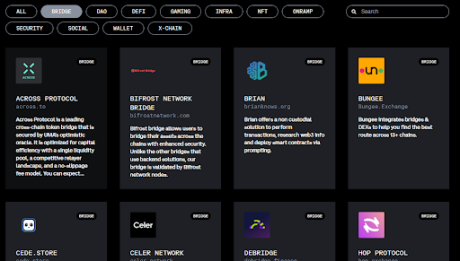Academy
How To Buy, Sell, And Trade Crypto On The Base Network
Published
5 months agoon
By
admin
The foundational infrastructure of the Base Network brings about yet another Ethereum Layer 2 network, distinguished by its scalability and empowerment through the notable association with Coinbase. Coinbase is recognized globally as one of the most trusted cryptocurrency exchanges and companies, Coinbase effectively manages a diverse portfolio of crypto assets, solidifying its status as a cornerstone within the digital currency realm.
Positioned as a pivotal solution to address the persistent challenge of high transaction costs within the Ethereum network, the Base Chain stands quite firmly to revolutionize transaction fees, delivering a cost-effective alternative within the secure Ethereum environment. The assurance of a safe and reliable ecosystem is heightened by the affiliation with Coinbase, an industry titan renowned for its unwavering commitment and 10-year-long track record of great service.
Reasons To Trust The Base Chain
The current centralized phase of the Coinbase company, with its owners and Devs known to the public, establishes a solid foundation for users to place their trust in the Base chain. With over a decade of extensive experience in the cryptocurrency space, Coinbase has consistently demonstrated its expertise by developing and launching numerous successful crypto products.
This wealth of experience instills confidence in the Base Chain as it navigates its initial stages of centralization, with a strategic vision to progressively evolve into a decentralized entity over time.
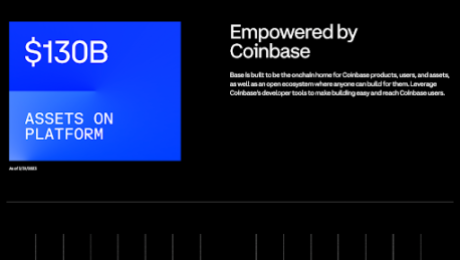
For those embarking on their journey within the Base Chain ecosystem, it is imperative to keep certain key considerations in mind. Firstly, the association with Coinbase serves as a testament to the network’s reliability and credibility. Additionally, users can anticipate ongoing enhancements and decentralization initiatives as the Base Chain matures, aligning with the broader ethos of blockchain technology.
In summary, the Base Network, fortified by its affiliation with Coinbase, emerges as a promising Ethereum Layer 2 solution, poised to alleviate the burden of high transaction costs while providing a secure and gradually decentralized environment.
Key Features To Note About Base Chain
- Absence of Native Token: Notably, the Base Chain currently operates without a native token. Instead, transaction fees within the ecosystem are conducted using Base ETH. This choice streamlines interactions on the Base Chain and positions it as a unique player within the cryptocurrency landscape on the Ethereum chain. Some chain accepts their native token for gas fees but the Base chain accepts Base ETH.
- Layer 2 Security Powered by Ethereum: The Base Chain distinguishes itself as a layer 2 chain, constructed upon the robust Ethereum technology. This strategic integration ensures a heightened level of security, leveraging the well-established reputation of Ethereum as one of the most secure technologies in the crypto community. Consequently, the Base Chain is anticipated to offer a security profile close to the Ethereum Layer 1 network.
- Developer Transparency and Coinbase Backing: In contrast to many emerging chains, the Base Chain stands out due to its transparent development process and substantial backing by Coinbase. The association with Coinbase, a leading cryptocurrency exchange, lends credibility and trust. Considering Coinbase’s track record of providing crypto products to over 100 million users and processing $80 billion worth of crypto assets without controversies, users can confidently rely on the expertise of the development team.
- Anticipated Low Gas Fees: One of the attractive features of the Base Chain is the expectation of significantly lower gas fees compared to the native Ethereum chain. This affordability factor provides users with an opportunity to experience Ethereum Layer 1 compatibility at a fraction of the cost, enhancing the cost-effectiveness of transactions on the Base Chain.
- Open Source Technology with Optimism Integration: The Base Chain’s Open Source technology is powered by the Optimism Open Source chain. This integration not only supports the overall functionality of the chain but also simplifies the development process for creators. Developers can anticipate a user-friendly environment for building applications on the Base Chain, thanks to the enhanced capabilities and support provided by the Optimism Open Source chain.
Expanding on the diverse utilities and functionalities within the Base Ecosystem
- Bridging Utility: The Base Ecosystem has a bridging utility, facilitating seamless interoperability with other blockchain networks. This feature enhances the overall connectivity of the Base Chain, allowing for the fluid transfer of assets and data across different blockchain environments.
- DeFi (Decentralized Finance) Utility: Positioned at the forefront of decentralized finance, the Base Ecosystem provides comprehensive support for DeFi applications. Users can engage in a spectrum of financial services, including lending, borrowing, and trading, all within the secure and efficient framework of the Base Chain.
- Gaming Utility: Acknowledging the growing significance of blockchain in the gaming industry, the Base Ecosystem integrates a gaming utility. This functionality opens avenues for the development and deployment of blockchain-based games, ensuring a secure and transparent gaming experience for users.
- Social Utility: Recognizing the social aspect of blockchain technology, the Base Ecosystem incorporates a social utility. This facet enables the creation and deployment of decentralized social applications, fostering interactions, and transactions within a secure and trustless environment.
- NFT (Non-Fungible Token) Utility: The Base Ecosystem extends its utility to support Non-Fungible Tokens (NFTs), a rapidly evolving and popular aspect of the blockchain space. Users can create, trade, and interact with NFTs seamlessly, leveraging the secure infrastructure of the Base Chain.
- Compatibility with EVM-Supported Wallets: The Base Ecosystem ensures widespread accessibility by allowing users to utilize and access its utilities through different Ethereum Virtual Machine (EVM) supported wallets. This compatibility enhances user convenience, as individuals can leverage familiar wallets to engage with the diverse utilities offered by the Base Chain.
How To Buy, Sell, And Trade On The Base Network
Select an EVM-Compatible Wallet
To be able to make any transactions on the Base network, you need to have an EVM-Compatible Wallet. Click here to see a list of wallet options you can select from but I would recommend you use MetaMask, it is one of the most popular Ethereum Virtual Machine (EVM)-compatible wallets and also one of the most used wallets for Base Network transactions.
If you are using a PC, install the Metamask wallet extension by clicking on “Add to Chrome” to add the extension to your Chrome browser, as shown below:
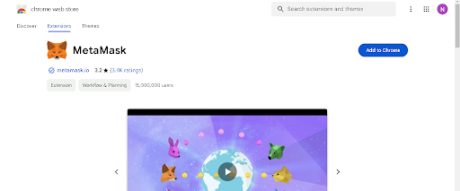
Once installed, open your MetaMask, set up your account, and make sure to keep your secret phrase very safe, I would advise that you write it down on a shit of paper, away from the internet where it can’t be hacked.
Add The BASE Network To Your MetaMask
To add the Base Network to your MetaMask, search for Chainlist on your browser, open it, connect your MetaMask wallet, search for Base, and add it to MetaMask by clicking on “Add to Metamask”, click on “Approve” and lastly click on “Switch Network” on your Metamask.
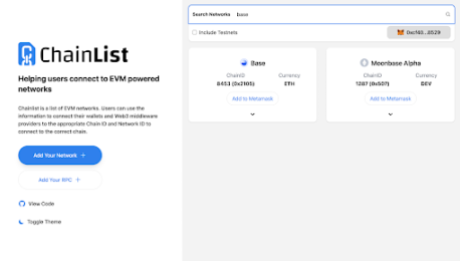
Acquire Base ETH
To make any transaction on the Base Network, you need Base ETH. Get your Base ETH from these cryptocurrency exchanges such as Binance, OKX, or KuCoin. Buy ETH on these platforms, go to the withdraw section, making sure to choose the BASE network as your transfer Network, which automatically converts your ETH to Base ETH as it gets to the ETH wallet destination.
Related Reading: How To Buy, Sell, and Trade Tokens On The Arbitrum Network
Alternatively, if you already have native ETH in your Metamask wallet, you can use the BASE bridge to bridge from the Ethereum Mainnet to the Base Network.
Bridging to Base Network ETH From Other Ethereum Layer 2s
If you wish to bridge your ETH to Base ETH from other Ethereum Layer 2 solutions, I would recommend secondary bridging platforms featured on the BASE Bridge platform. These platforms facilitate a smooth transition to the Base Network from various Ethereum Layer 2 environments, as shown below.
Example Of Bridging to Base ETH From Other Ethereum Layer 2s
ACROSS PROTOCOL is the first secondary bridging platform featured on the BASE Bridge platform as shown above, all you need to do is connect your Metamask wallet and select the amount of ETH you want to bridge to Base ETH and Bridge.
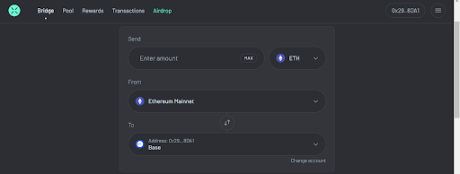
After Acquiring your Base ETH, you need to do your research and know which token you want to buy on the Base Network on Coingecko before heading over to Dexscreener to check for the token, Dexscreener serves as a valuable tool for checking available tokens on the EVM chain, including the Base Network.

By selecting the Base network on Dexscreener, you can access a comprehensive chart of available Base tokens. Note that not all tokens are supported on every DeFi DEX, search for the token you would like to trade and select it. After selecting, look out for the Green Box section selected in the image to identify which DeFi platforms support the token you wish to trade.
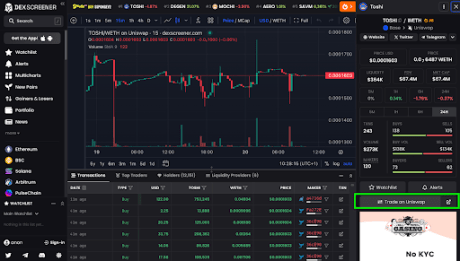
Obtaining Token Contract Address
Scroll down on the Dexscreener to find the token contract address or go back to Coingecko and copy the contract address. This address is crucial when trading on DeFi platforms.
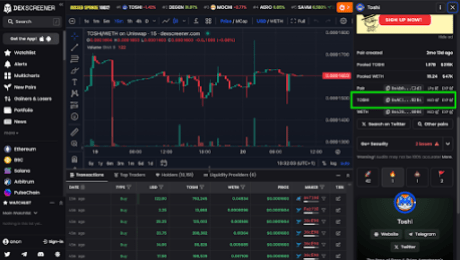
Copy the contract address, and when you enter it in the swap section of a DeFi platform like Uniswap, it will reveal the token. If the token is not available on Uniswap, the Dexscreener will redirect you to another supported DeFi where you can trade the token like KyberSwap.
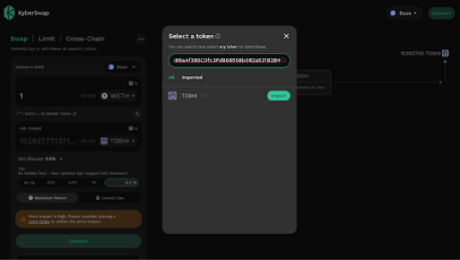
Connect your wallet to KyberSwap, click on the denominator token, and paste the contract address of the Base token in the search box. Before initiating any trade on DeFi, confirm that the network on the DeFi is on, in this case, the Base Network, ensuring the token’s availability on the Base Network. If it’s not initially on the Base Network, go to “Select a chain”, and select the Base network to ensure compatibility.
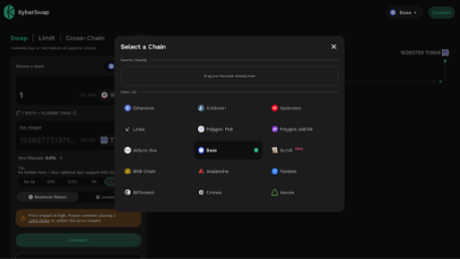
Choose the desired pair of Base tokens and ETH (or other base pairs), specify the amount you want to swap, and execute the trade.
Related Reading: How To Buy, Sell, And Trade Tokens On The BSC Network
Reverse Trading For Base Network ETH
If you wish to trade from a BASE token to Base ETH, simply reverse the order. Place the Base token at the top and the ETH at the bottom, then proceed with the swap. This allows you to exchange your Base token for ETH within the Base Network.
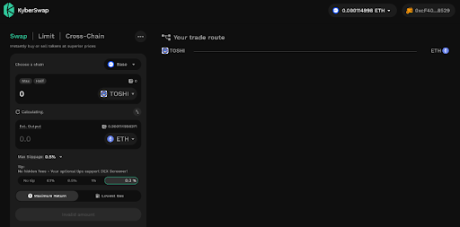
By following these steps, you can confidently navigate the trading process on the Base Network, leveraging the features of DeFi platforms and Dexscreener to make informed decisions and execute trades seamlessly.
Conclusion
The Base Network is another Ethereum Layer 2 network which is also affiliated with Coinbase, which is one of the most trusted cryptocurrency exchanges and companies in the crypto space with over 100 million users and processing $80 billion worth of crypto assets. Base Network has a lot of features which I have pointed out in the article already, although the Base Network does not have its Native token yet, it is still trusted and reliable due to its affiliation with Coinbase.
Featured image from TronWeekly
Disclaimer: The article is provided for educational purposes only. It does not represent the opinions of NewsBTC on whether to buy, sell or hold any investments and naturally investing carries risks. You are advised to conduct your own research before making any investment decisions. Use information provided on this website entirely at your own risk.
Source link
You may like


What’s the best new crypto in 2024?


Bitcoin Mining Difficulty Crashes 5% To Lowest Level In 3 Months, What Happens Next?


Bitcoin (BTC) Price, Volume Contrasts In Fight For Rebound


The German Government Is Selling More Bitcoin – $28 Million Moves to Exchanges


BC.GAME Announces the Partnership with Leicester City and New $BC Token!


Justin Sun Says TRON Team Designing New Gas-Free Stablecoin Transfer Solution
Academy
Top 10 Proof Of Work Blockchains Like Bitcoin
Published
4 months agoon
February 25, 2024By
admin
Proof of Work blockchains stand as the cornerstone of cryptocurrency technology, first popularized by Bitcoin, the original cryptocurrency. At their core, these blockchains rely on a consensus mechanism called Proof of Work (PoW). This mechanism is essential for validating transactions and creating new blocks without the need for a central authority.
In a PoW blockchain, miners compete to solve complex mathematical puzzles. The first miner to solve the puzzle gets the opportunity to add a new block to the blockchain and is rewarded with cryptocurrency. This process not only secures the network against fraudulent transactions but also ensures its decentralization and integrity.
The ingenuity of Proof of Work lies in its simplicity and effectiveness. It leverages computational power to maintain network security, making any attempt to alter transaction data not just difficult, but economically not feasible. As the pioneer of this technology, Bitcoin has demonstrated the robustness and reliability of PoW blockchains, setting a benchmark for countless cryptocurrencies that followed.
Understanding Proof Of Work Blockchains
Proof of Work (PoW) blockchains are foundational to the cryptocurrency ecosystem, embodying a consensus mechanism that is both secure and decentralized. This innovative approach to consensus ensures the integrity, security, and continuity of the blockchain without necessitating a central authority.
What Makes A Proof Of Work Blockchain?
A Proof of Work (PoW) blockchain is distinguished by its consensus mechanism, which is intricately designed to ensure network security, decentralization, and transaction integrity through computational effort. This mechanism revolves around several pivotal elements that together define the PoW paradigm:
- Cryptographic Puzzle Solving (Hashing): At the heart of PoW is the requirement for miners to solve complex cryptographic puzzles. These puzzles involve calculating a hash—a fixed-size alphanumeric string—that meets specific criteria set by the blockchain network.
- Adjustable Difficulty Target: The PoW algorithm adjusts the difficulty of the cryptographic puzzle to maintain a constant block time, despite fluctuations in the network’s total hashing power. This dynamic adjustment ensures consistent block creation rates, which are crucial for the stability and predictability of the blockchain.
- Network Security Through Work: The foundational principle behind PoW is that the security of the blockchain is directly proportional to the amount of work (computational power) invested in it. Successfully solving a puzzle requires a significant investment in hardware and electricity, making it economically impractical to conduct attacks.
- Decentralization And Participation: PoW encourages a decentralized network structure by allowing anyone with the necessary computational resources to participate in mining. This openness fosters a competitive mining environment and reduces the risk of centralized control, which is pivotal for the autonomy and resilience of the blockchain.
- Miner Incentivization: Miners are rewarded for their efforts with a combination of block rewards (newly minted coins) and transaction fees.
- Immutability And Trust: The PoW consensus model underpins the blockchain’s immutability. Altering any previously confirmed block would require re-mining not only that block but also all subsequent blocks, a feat that demands an unrealistic amount of computational power.
Advantages Of Proof Of Work Blockchains
The implementation of PoW consensus mechanisms brings forth several advantages that are critical to the functionality and security of blockchain technology:
- Robust Security Model: The sheer computational work required to validate transactions and mine new blocks makes PoW blockchains incredibly secure. This security model effectively prevents the feasibility of 51% attacks, where an entity would need to control the majority of the network’s hashing power to manipulate the blockchain.
- Immutable Ledger: PoW contributes to the immutability of the blockchain, ensuring that once a transaction is confirmed and added to the ledger, reversing it becomes computationally infeasible. This property is vital for trust and reliability in the system.
- Network Integrity: Through the process of mining and the rewards system, PoW blockchains encourage participants to act honestly. The cost of attempting to cheat the system (in terms of wasted computational power and energy) outweighs the potential benefits, thereby maintaining the integrity of the network.
- Transparent And Verifiable: All transactions on a PoW blockchain are transparent and can be independently verified by any participant. This transparency builds trust among users and is fundamental for the operation of a decentralized financial system.
Top 10 Proof of Work Blockchains Like Bitcoin
Below is a list of the top 10 Proof of Work (PoW) blockchains by market cap (as of February 2024):
Bitcoin: The Pioneer Proof Of Work Blockchain
Bitcoin stands as the original and most renowned Proof of Work blockchain. Launched by an anonymous entity or group under the pseudonym Satoshi Nakamoto in 2009, Bitcoin introduced the world to the concept of decentralized digital currency. At its core, Bitcoin operates on a PoW consensus mechanism, which is fundamental to its design for securing transactions and minting new coins.

Technical Innovation:
Bitcoin’s introduction of blockchain technology represented a revolutionary leap forward in digital trust. By enabling a decentralized network of miners to validate transactions by solving complex cryptographic puzzles, Bitcoin solved the double-spending problem without the need for a central authority.
Security:
The security of the Bitcoin network is unparalleled, largely due to the massive amount of computational power contributed by miners around the globe. This distributed network of miners makes it nearly impossible for any single actor to manipulate the blockchain or reverse transactions, ensuring the integrity and trustworthiness of the entire system. The latest study by Lucas Nuzzi, Head of R&D at CoinMetric, showed that a 51% attack would cost at least $20 billion and is logistically near impossible.
Impact on Cryptocurrency:
Bitcoin not only pioneered the PoW mechanism but also laid the groundwork for the cryptocurrency industry. Its success has inspired the creation of thousands of alternative cryptocurrencies, many of which have adopted or adapted its PoW model. Bitcoin remains the gold standard in the space, often referred to as “digital gold,” symbolizing its status as a store of value and a hedge against traditional financial systems.
Network and Adoption:
Over the years, Bitcoin has seen exponential growth in both adoption and value. It has transitioned from a niche digital currency to a mainstream financial asset recognized by individuals, corporations, and even some governments. The network continues to grow, supported by a robust and dedicated community of developers, miners, and enthusiasts who ensure its ongoing development and security.
Dogecoin: From Meme To Mainstream
Dogecoin, originally created as a lighthearted joke in 2013, has evolved from a meme-inspired cryptocurrency to a significant player within the Proof of Work (PoW) blockchain ecosystem. Designed by Billy Markus and Jackson Palmer, Dogecoin was intended to mock the wild speculation of the cryptocurrency market. However, its fun and friendly approach led to a vibrant and supportive community, propelling Dogecoin from a humorous experiment to mainstream relevance.
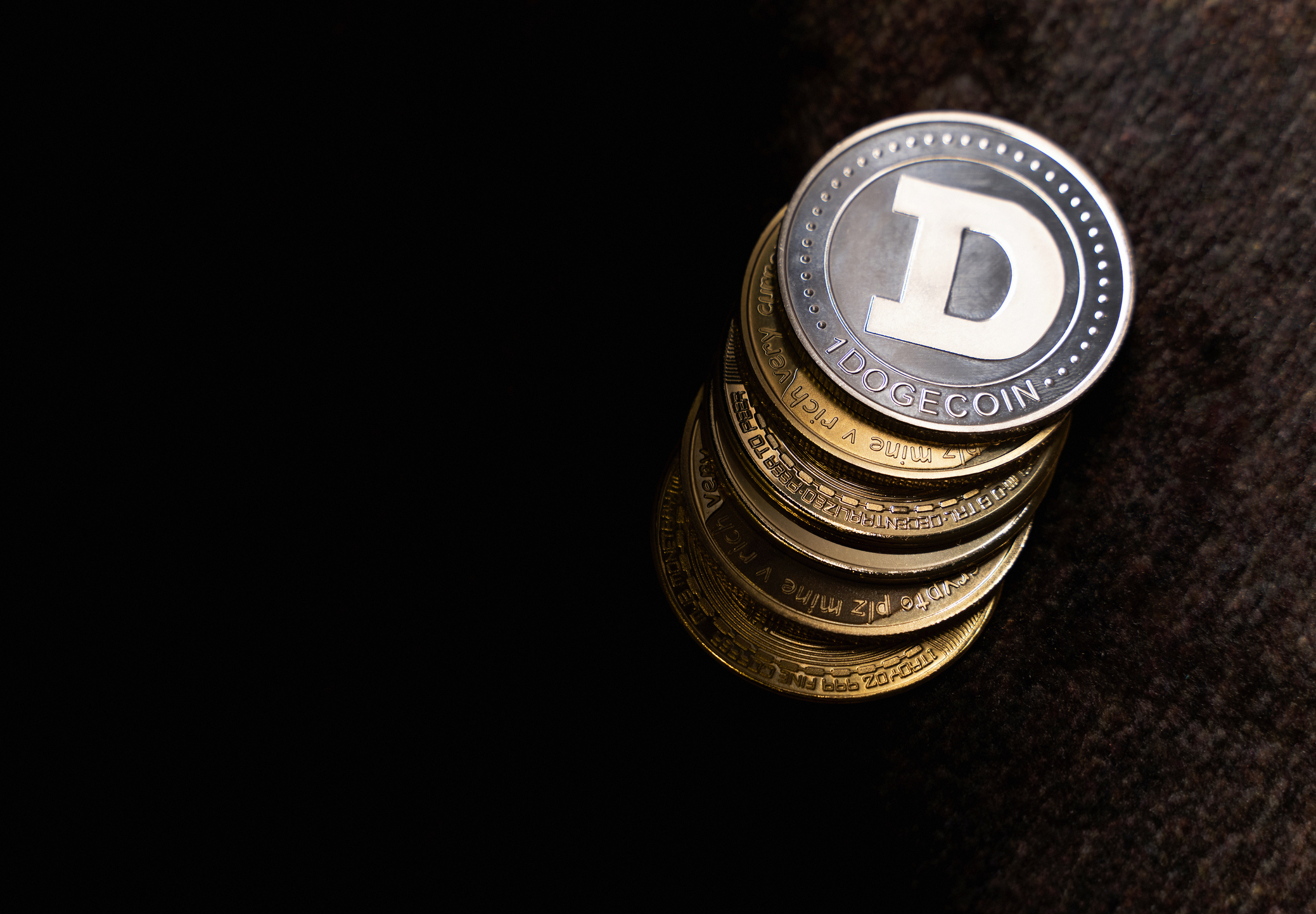
Community and Culture:
At the heart of Dogecoin’s unexpected rise to fame is its strong, welcoming community. Unlike other cryptocurrencies that focus on technical aspects or financial gains, Dogecoin emphasizes camaraderie and charitable endeavors. This unique culture has fostered a loyal following, contributing to its resilience and growth.
Technical Foundation:
Despite its whimsical origins, Dogecoin shares the PoW consensus mechanism with Bitcoin, albeit with some modifications. It uses the Scrypt algorithm, which is less energy-intensive compared to Bitcoin’s SHA-256. This choice was strategic, making Dogecoin mining more accessible to individuals without specialized hardware.
Market Impact And Use Cases:
Dogecoin’s journey to mainstream recognition was bolstered by social media and high-profile endorsements, including tweets from celebrities like Elon Musk. These endorsements have led to significant price fluctuations, highlighting Dogecoin’s volatility but also its growing relevance as both a digital currency and a cultural phenomenon.
Initially intended for tipping and small transactions on social media, Dogecoin’s use cases have expanded. It is now accepted by a variety of merchants and has been used in fundraising for charitable causes, showcasing its utility beyond mere speculation. Despite its origins, Dogecoin has demonstrated real-world value, contributing to its endurance in the crypto space.
Future Prospects:
Dogecoin continues to evolve, with its community and developers exploring ways to improve its functionality, efficiency, and scalability. While it may not match the technical ambitions of other cryptocurrencies, Dogecoin’s strength lies in its unique blend of humor, heart, and a committed community, making it a noteworthy and enduring participant in the Proof of Work blockchain landscape.
Litecoin: The Silver To Bitcoin’s Gold
Litecoin, created by Charlie Lee in 2011, is often considered the silver to Bitcoin’s gold. It was developed to address some of the perceived limitations of Bitcoin, primarily aiming to offer faster transactions and lower fees. As a Proof of Work (PoW) blockchain, Litecoin shares many of Bitcoin’s core principles but introduces key technical adjustments that distinguish it within the cryptocurrency space.
Technical Innovations:
One of the most significant innovations of Litecoin is its use of the Scrypt hashing algorithm, as opposed to Bitcoin’s SHA-256. The Scrypt algorithm is less susceptible to the kind of high-powered ASIC mining rigs that dominate Bitcoin mining. This decision was made to democratize mining, allowing individuals with less specialized hardware to participate in the network. Moreover, Litecoin offers faster block generation times—approximately 2.5 minutes compared to Bitcoin’s 10 minutes—enabling quicker transaction confirmations.
Market Position And Adoption:
Since its inception, Litecoin has consistently ranked among the top cryptocurrencies by market capitalization. Its longevity and stability have earned it a trusted position in the market. Merchants and users who seek faster transactions with lower fees have adopted Litecoin, using it for a variety of transactions, from e-commerce to cross-border payments.
Security And Network:
Despite its faster transaction times and different mining algorithm, Litecoin maintains a robust level of security. The PoW consensus mechanism, coupled with the widespread distribution of miners, ensures that the network remains decentralized and resistant to attacks. Litecoin’s active developer community continues to innovate, proposing upgrades and improvements to enhance security, scalability, and user experience.
Community And Future Directions:
Litecoin benefits from a strong, active community that supports its development and adoption. This community involvement has been crucial for Litecoin’s resilience and growth. Educational resources, developer contributions, and merchant adoption initiatives are regularly supported by the community, fostering a healthy ecosystem around the cryptocurrency.
Litecoin’s roadmap includes ongoing efforts to improve scalability and privacy on the network. Innovations such as the MimbleWimble extension block (MWEB) aim to enhance privacy features, addressing one of the criticisms of Litecoin and other similar cryptocurrencies. These developments indicate Litecoin’s commitment to evolving in response to user needs and technological advancements.
Bitcoin Cash: The Result Of The “Blocksize War”
Bitcoin Cash emerged in 2017 as a direct response to the debates surrounding Bitcoin’s scalability challenges. Created from a hard fork of Bitcoin, it aims to fulfill the original vision of Bitcoin as a peer-to-peer electronic cash system with enhanced transaction speed and lower fees. As a Proof of Work (PoW) blockchain, Bitcoin Cash retains many of Bitcoin’s fundamental characteristics while introducing critical changes to improve scalability and usability.
Technical Enhancements For Speed:
The primary distinction between Bitcoin Cash and its predecessor lies in its block size. Bitcoin Cash increased the block size limit from 1 MB to an initial 8 MB, with subsequent upgrades allowing blocks up to 32 MB. This expansion significantly increases the number of transactions that can be processed per block, reducing transaction fees and improving processing times. These changes address one of the core issues Bitcoin faced—its inability to process transactions quickly during peak usage times.
Market Reception And Adoption:
Since its inception, Bitcoin Cash has secured a place among the top cryptocurrencies by market capitalization. Its commitment to maintaining low transaction fees and fast processing times has attracted users and merchants looking for efficient digital transactions. The cryptocurrency has seen adoption for a variety of uses, including online payments, remittances, and as a means of exchange for goods and services.
Security And Decentralization:
Despite the changes in block size, Bitcoin Cash continues to uphold the security standards set by Bitcoin. The PoW consensus mechanism ensures the network remains secure against attacks, and the decentralized nature of mining activities promotes network health and integrity. However, debates have arisen within the community regarding the potential for centralization due to the increased block size, which could, theoretically, require more substantial computational resources to mine effectively.
Looking Forward:
The future of Bitcoin Cash hinges on its ability to balance scalability, security, and decentralization. Ongoing efforts to enhance the network’s underlying technology and address challenges related to block size and transaction efficiency are critical.
However, it needs to be pointed out that BCH has somewhat failed against Bitcoin. It has not managed to match BTC in terms of price performance. The following chart illustrates the price comparison of Bitcoin Cash to Bitcoin since 2017. Despite having backing from key figures like Roger Ver, BCH has not seen widespread adoption, mostly because of limited demand for its increased block size.
Ethereum Classic: Preserving Originality
Ethereum Classic (ETC) emerged from a philosophical divide within the Ethereum community, following a contentious hard fork in 2016. This split was the result of differing opinions on how to handle the aftermath of the DAO attack, a significant security breach that led to the loss of millions of dollars worth of Ethereum.
ETC embodies the principle of “code is law,” maintaining the original Ethereum blockchain without reversing the DAO attack transactions. As a Proof of Work (PoW) blockchain, Ethereum Classic upholds the sanctity of immutability and the original vision of Ethereum as an unalterable digital ledger.
Technical Foundation And Development:
The core ethos of Ethereum Classic is its unwavering commitment to blockchain immutability. In the blockchain context, immutability refers to the principle that once transactions are confirmed, they cannot be altered or reversed. Ethereum Classic’s stance on this principle reflects a fundamental belief in the importance of preserving the integrity of the blockchain, even in the face of challenges and disputes.
Despite sharing its roots with Ethereum, Ethereum Classic operates as a distinct entity with its development path. It maintains the original Ethereum blockchain’s capabilities, supporting smart contracts and decentralized applications (DApps) with the added emphasis on security and stability.
Security Considerations:
Ethereum Classic’s commitment to preserving the original Ethereum blockchain has not come without its challenges, particularly in the realm of security. The network has been subject to several 51% attacks, where attackers gained majority control of the network’s hash rate, enabling them to double-spend coins. These incidents have sparked discussions about the security of PoW blockchains, especially those with a smaller network size and hash rate compared to their larger counterparts.
Development And Future Outlook:
In response to security challenges, the Ethereum Classic community and its developers have been working on solutions to enhance network security and prevent future attacks. Proposals include modifying the consensus mechanism to make 51% attacks more difficult and expensive to execute. Additionally, Ethereum Classic continues to evolve, with ongoing development efforts aimed at improving scalability, interoperability, and the overall utility of the network.
Kaspa: The Newcomer
Kaspa emerges as the latest entrant in the Proof of Work (PoW) blockchain arena, distinguishing itself through innovative technology and a forward-thinking approach to scalability and transaction speed. As a newcomer, Kaspa aims to address some of the most pressing issues faced by traditional PoW blockchains, such as Bitcoin and Ethereum Classic, by introducing a novel blockDAG (Directed Acyclic Graph) structure.
This groundbreaking architecture enables Kaspa to offer unprecedented transaction throughput and minimal confirmation times, setting a new standard for performance in the PoW landscape.

Innovative Architecture And Scalability:
The core innovation behind Kaspa is its use of a blockDAG framework, a departure from the traditional blockchain linear model. In this structure, blocks are connected in a DAG pattern, allowing for multiple blocks to be added to the network simultaneously. This parallel processing capability significantly increases the network’s capacity and transaction speed, effectively addressing the scalability limitations inherent in conventional blockchain systems.
Kaspa’s blockDAG architecture allows it to process thousands of transactions per second (TPS), a remarkable feat compared to the transaction throughput of legacy PoW blockchains. Furthermore, the DAG structure reduces transaction confirmation times to mere seconds, enhancing the user experience and making Kaspa an attractive platform for real-time applications and microtransactions.
Market Position And Adoption:
As a newcomer, Kaspa faces the challenge of establishing itself in a market dominated by well-entrenched blockchains. However, its technological advancements and promise of high scalability and low transaction costs have garnered attention from developers, miners, and users alike.
Security And Decentralization:
Despite its novel architecture, Kaspa remains committed to the principles of security and decentralization that are hallmarks of PoW blockchains. The blockDAG structure, while more complex than a linear blockchain, is designed to maintain a high level of security against attacks, including double-spending and 51% attacks. Moreover, Kaspa’s PoW consensus mechanism ensures that the network remains decentralized, with no single entity able to control the majority of the hashing power.
Future Directions And Challenges:
Looking forward, Kaspa aims to continue its trajectory of rapid development and community growth. The project’s roadmap includes enhancements to its core protocol, improvements in user interface and experience, and the exploration of new use cases enabled by its high-speed, scalable infrastructure.
However, Kaspa’s success will depend on its ability to overcome the challenges of network security, user adoption, and competition from both established blockchains and emerging technologies.
Monero: Privacy As A Priority
Monero stands out in the Proof of Work blockchain space with its unwavering commitment to privacy and security. Unlike many cryptocurrencies that offer transparent blockchain transactions, Monero ensures the anonymity of its users through advanced cryptographic techniques. This focus on privacy makes Monero a favored choice for individuals seeking financial confidentiality in their transactions.
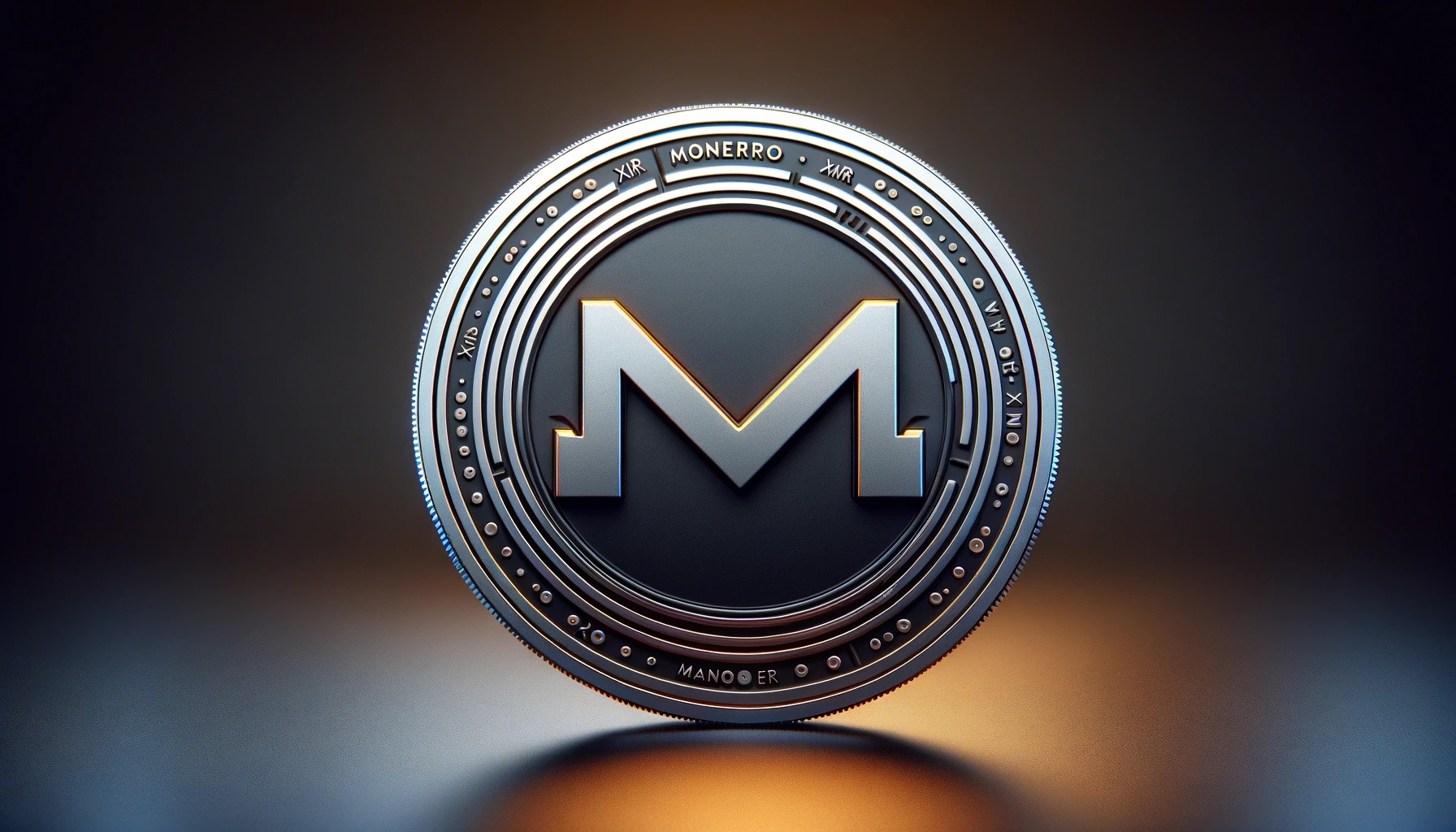
Advanced Privacy Features:
At the heart of Monero’s privacy mechanism are ring signatures, stealth addresses, and Ring Confidential Transactions (RingCT). Ring signatures obscure the sender’s identity by mixing their transaction with others’, making it virtually impossible to trace the transaction back to its origin.
Stealth addresses add another layer of privacy by creating a one-time address for each transaction, protecting the recipient’s identity. RingCT further enhances privacy by concealing the transaction amount, ensuring all aspects of a transaction are kept confidential.
Monero’s advanced privacy features ensure that users can conduct transactions without the fear of surveillance or tracking. This level of anonymity is critical in an era where financial privacy is increasingly under threat. By encrypting transaction details, Monero provides a secure environment for users to send and receive funds without exposing their financial activities to the public or any prying eyes.
Market Adoption and Use Cases: Monero’s focus on privacy has led to a broad range of use cases, from individuals seeking to protect their financial privacy to businesses requiring confidential transactions. However, this emphasis on anonymity has also attracted controversy, with Monero being associated with illicit activities on the dark web.
Regulatory Challenges And Future Outlook:
The privacy features that make Monero attractive to users also pose significant challenges in terms of regulatory compliance. Governments and financial institutions are increasingly concerned about the potential for cryptocurrencies like Monero to be used for money laundering and other illegal activities. Several crypto exchanges worldwide have already delisted Monero, pressured by local governments and laws.
As the digital landscape evolves, Monero’s commitment to privacy remains unwavering. The development team and community are continually working on improving Monero’s privacy features and usability, ensuring that it remains at the forefront of secure and private digital transactions. Despite regulatory hurdles, Monero’s dedication to protecting user privacy positions it as a critical player in the ongoing discourse on financial privacy and security in the digital age.
Bitcoin SV: Craig Wright’s Vision
Bitcoin SV (BSV) represents a distinctive branch in the evolution of Bitcoin, advocating a return to what its proponents consider Satoshi Nakamoto’s original vision for the cryptocurrency. It emerged from a hard fork of Bitcoin Cash (BCH) in 2018, centering around disagreements on the direction and scalability of Bitcoin.
Craig Wright, a polarizing figure in the cryptocurrency community, has been a vocal advocate for Bitcoin SV, claiming it to be the true Bitcoin as originally intended by Satoshi Nakamoto. However, it’s crucial to note that Craig Wright’s assertions of being Satoshi Nakamoto are marred by controversy and lack conclusive evidence.
The ongoing COPA (Crypto Open Patent Alliance) trial further scrutinizes Wright’s claims, highlighting discrepancies and alleged falsehoods in his assertions.
Controversy Surrounding Craig Wright: Wright’s claim to be Satoshi Nakamoto, the pseudonymous creator of Bitcoin, has been a subject of intense debate and legal scrutiny. Despite his assertions, Wright has not provided irrefutable cryptographic proof of ownership of the early Bitcoin keys, a step that would be essential to conclusively proving his identity as Satoshi.
The COPA trial, among other legal challenges, casts a long shadow over Wright’s claims, with the crypto community and wider public remaining skeptical of his assertions due to the lack of verifiable evidence and the emergence of contradictory statements.
Bitcoin SV’s Proposition:
Despite the controversies surrounding its main proponent, Bitcoin SV aims to fulfill what its supporters believe was Nakamoto’s original vision for Bitcoin — a peer-to-peer electronic cash system capable of scaling massively to serve as a global payment system.
Bitcoin SV advocates for larger block sizes to handle more transactions and reduce fees, a key point of divergence from Bitcoin (BTC) and Bitcoin Cash (BCH). The network has implemented significant block size increases, aiming to facilitate greater transaction throughput and enable a wide range of applications, from micropayments to enterprise-level data processing.
Looking Forward:
Bitcoin SV’s market position has been influenced by its technical propositions as well as the controversies of its leading figure. While it has established a niche within the broader cryptocurrency ecosystem, BSV’s adoption and acceptance have been impacted by the ongoing debates over Wright’s claims to be Satoshi Nakamoto. BSV has never ever gained much traction. The BSV/BTC chart shows the lackluster performance.
Conflux Network: Bridging East And West
Conflux Network emerges as a unique Proof of Work (PoW) blockchain with a mission to bridge the technological and regulatory divides between the East and West. Leveraging a novel tree-graph consensus mechanism, Conflux Network aims to offer high throughput, scalability, and security without compromising decentralization — a proposition that addresses some of the most pressing challenges in blockchain technology.
Innovative Consensus Mechanism:
At the heart of Conflux Network’s innovation is its tree-graph consensus algorithm, which allows for the concurrent processing of blocks and transactions. This design significantly enhances the network’s capacity and speed, enabling higher transaction throughput compared to traditional blockchain systems. This technical advancement is crucial for achieving the network’s vision of supporting global decentralized applications (dApps) and services.
Strategic Positioning In The Global Market:
Conflux Network has strategically positioned itself as a bridge between the Eastern and Western worlds in the context of blockchain technology and cryptocurrency. By complying with regulatory standards in China, where it is primarily based, Conflux has managed to secure a unique position in one of the largest markets in the world. This compliance has opened avenues for collaboration with government and private sector projects, distinguishing Conflux from many other blockchain projects that face regulatory challenges.
Through its commitment to regulatory compliance and its technological infrastructure, Conflux Network facilitates cross-border collaboration and transactions. It aims to foster a global ecosystem where developers, enterprises, and users from different jurisdictions can participate in the blockchain economy with reduced friction and increased trust. By doing so, Conflux not only addresses technical challenges but also navigates the complex landscape of international regulations and policies.
Challenges And Opportunities:
Despite its innovative approach and strategic advantages, Conflux Network faces challenges common to many blockchain projects, including the need for wider adoption and recognition in the crowded cryptocurrency space.
However, its unique position as a compliant, scalable, and high-throughput blockchain presents significant opportunities. By continuing to build partnerships and expand its ecosystem, Conflux has the potential to play a pivotal role in the global blockchain landscape, facilitating a more interconnected and efficient digital economy.
Siacoin: Revolutionizing Storage
Siacoin stands out in the blockchain ecosystem as a pioneering platform aimed at revolutionizing digital storage by decentralizing it. As a proof of work (PoW) blockchain, Siacoin offers a secure, private, and cost-effective solution for storing data across a distributed network. This approach not only challenges traditional cloud storage providers but also aligns with the growing demands of the AI and decentralized private networks (DePIN) sectors for reliable, scalable storage solutions.
Decentralized Storage For AI:
In the era of AI, the need for vast amounts of data storage is undeniable. AI models require extensive datasets for training and operation, often entailing significant storage costs and security concerns. Siacoin’s decentralized storage model offers a compelling solution by distributing data across a global network of nodes. This method ensures redundancy, lowers costs, and enhances data privacy and security — key advantages for AI developers and companies seeking efficient ways to manage their data.
The concept of DePIN (Decentralized Private Networks) is gaining traction as a means to enhance privacy and security in digital communications and transactions. Siacoin’s infrastructure naturally complements this sector by providing a decentralized storage solution that can be integral to DePIN architectures. By ensuring data is stored securely and spread across multiple nodes, Siacoin mitigates risks associated with centralized data breaches and offers a robust foundation for DePIN applications.
The intersection of AI and cryptocurrency is an exciting frontier for innovation. Siacoin directly contributes to this narrative by addressing one of the most pressing needs in the AI space: scalable and secure data storage.
The platform’s use of blockchain technology ensures integrity and accessibility of data, which is crucial for AI applications that rely on vast datasets. Additionally, Siacoin’s payment model, which uses its native cryptocurrency (SC) for transactions, seamlessly integrates with the crypto economy, providing a streamlined approach for users to engage with decentralized storage services.
Innovation And Looking Ahead:
While Siacoin presents a groundbreaking approach to data storage, it also faces challenges typical of decentralized platforms, such as user adoption, competition from established cloud storage providers, and the ongoing need to prove its reliability and efficiency at scale. However, its innovative use of blockchain technology to disrupt the traditional storage market positions Siacoin as a potential key player in the future of both the blockchain and AI industries.
As the demand for AI capabilities continues to grow, alongside the increasing importance of privacy and security in the digital realm, Siacoin’s role in the ecosystem could become increasingly pivotal. Its ability to provide a decentralized, secure, and cost-effective storage solution places it at the heart of the convergence between blockchain technology and AI.
The ongoing development of the platform and its adoption by the AI and DePIN sectors will be critical in determining its success and impact on the broader technology landscape.
Comparative Analysis Of Top Proof Of Work Blockchains
The landscape of Proof of Work blockchains is diverse, with each platform offering unique features, advantages, and challenges. This comparative analysis aims to shed light on the top PoW blockchains like Bitcoin, exploring their speed, security, scalability, community, and developer support. Understanding these facets can help users, investors, and developers make informed decisions in the blockchain space.
Speed:
Transaction speed is a critical metric for any blockchain. Bitcoin, the first and most well-known Proof of Work blockchain, processes transactions relatively slowly, with a capacity of 7 transactions per second (TPS) on the base layer. In contrast, newer blockchains like Kaspa aim to dramatically increase transaction speeds using novel consensus mechanisms, claiming to support thousands of TPS. Litecoin and Bitcoin Cash have also implemented various improvements to increase their transaction speeds and reduce confirmation times compared to Bitcoin.
Security:
Security is paramount in the blockchain world. PoW blockchains are renowned for their robust security models. Bitcoin remains the gold standard in security, leveraging its extensive network of miners to prevent attacks. Monero offers additional security features focused on privacy, using ring signatures and stealth addresses to protect user identities. While all Proof of Work blockchains prioritize security, the trade-off often comes in the form of increased energy consumption and slower transaction speeds.

Scalability:
Scalability remains a significant challenge for Proof of Workblockchains. Bitcoin has faced scalability issues, leading to high transaction fees and slower processing times during peak usage. Solutions like the Lightning Network for Bitcoin and sidechains like Stacks (STX) are being developed to address these limitations. Kaspa’s unique approach to scalability through its GHOSTDAG protocol highlights the ongoing innovation in this area, promising more scalable solutions within the PoW paradigm.
Community And Developer Support:
A strong community and developer support are crucial for the growth and sustainability of any blockchain. Bitcoin boasts the largest, active community of developers, contributing to the resilience and continuous improvement. Dogecoin, initially started as a joke, has garnered a massive community following, which has played a significant role in its adoption and endurance. Newer entrants like Kaspa and Conflux Network are rapidly building their communities, emphasizing the importance of engagement and support for long-term success.
FAQ: Top Proof of Work Blockchains
What Are The Top Proof Of Work Blockchains?
The top Proof of Work blockchains, known for their robust security and decentralization, include Bitcoin, Dogecoin, Litecoin, Bitcoin Cash, Ethereum Classic, Kaspa, Monero, Bitcoin SV, Conflux Network, and Siacoin. These blockchains leverage the Proof of Work consensus mechanism to validate transactions and secure their networks.
What Are Proof Of Work Blockchains?
Proof of Work blockchains are a type of decentralized ledger technology that uses a consensus mechanism requiring participants (miners) to solve complex mathematical problems to validate transactions and create new blocks. This process ensures security and integrity within the blockchain, preventing fraud and double-spending.
What Is The Biggest Proof Of Work Blockchain?
Bitcoin is the largest and most well-known Proof of Work blockchain in terms of market capitalization, user base, and network security. It was the first cryptocurrency to implement the Proof of Work mechanism, setting the standard for many that followed.
Who Invented Proof Of Work Blockchains?
The concept of Proof of Work predates Bitcoin, but Satoshi Nakamoto, the pseudonymous person or group of people who developed Bitcoin, was the first to implement it as a consensus mechanism for a cryptocurrency blockchain in 2009. This innovation paved the way for the development of other Proof of Work blockchains.
How Do I Invest In Top Proof Of Work Blockchains?
Investing in top Proof of Work blockchains typically involves buying the blockchain’s native cryptocurrency through a crypto exchange. Potential investors should create an account on a reputable exchange, deposit funds (fiat or crypto), and then purchase the desired cryptocurrency.
What Are the Alternatives To Proof Of Work Blockchains?
Alternatives to Proof of Work blockchains include Proof of Stake (PoS), Delegated Proof of Stake (DPoS), and other consensus mechanisms like Proof of Authority (PoA) and Proof of Space and Time. These alternatives seek to address some of the limitations of Proof of Work, such as its high energy consumption, by offering more energy-efficient and scalable solutions.
Featured image created with DALL·E
Disclaimer: The article is provided for educational purposes only. It does not represent the opinions of NewsBTC on whether to buy, sell or hold any investments and naturally investing carries risks. You are advised to conduct your own research before making any investment decisions. Use information provided on this website entirely at your own risk.
Source link
Academy
How To Mint BRC-20 Tokens On The Bitcoin Network
Published
5 months agoon
February 4, 2024By
admin
BRC-20 tokens open doors for developers to build their own decentralized applications (dApps) with unique economies on the Bitcoin network. This fosters community engagement through internal currencies, and attracting investment through innovative token sale structures.
BRC-20 tokens are fungible tokens built on the Bitcoin network using the Ordinals protocol. It also utilizes inscriptions containing JSON (JavaScript Object Notation) data to facilitate the deployment of token contracts, minting tokens, and transferring tokens. Presently, the BRC-20 token standard offers the ability to create a BRC-20 token using the deploy function, mint a specified quantity of BRC-20 tokens using the mint function, and transfer a designated amount of BRC-20 tokens through the transfer function.
BRC-20 and ERC-20 share some similar characteristics and functional concepts, but they are not identical due to their different underlying blockchains and implementation details. One of the differences is that BRC-20 tokens operate on the Bitcoin blockchain, while ERC-20 tokens reside on the Ethereum blockchain. This leads to differences in technical implementations and transaction fees.
Related Reading: How To Buy And Trade BRC-20 Tokens On The Bitcoin Network
Similar to ERC-20 tokens, BRC-20 tokens are fungible, meaning they can be exchanged on a one-to-one basis with equal value. They can be created, transferred, and traded on the Bitcoin network using decentralized marketplaces like Magic Eden with compatible wallets and decentralized exchanges that support the BRC-20 standard.
BRC-20 tokens breathe vitality into the Bitcoin network, acting as programmable extensions that expand the scope beyond basic transfers. They empower the Bitcoin network by enabling the development of DApps, fostering communities, and facilitating ownership of real-world assets. This dynamic frontier presents exciting opportunities for engagement, incentives, and innovation.
However, it is essential to navigate the technical intricacies and embrace the evolving infrastructure. BRC-20 tokens, still a work in progress, possess tremendous potential to reshape the future of Bitcoin, unveiling a multitude of tokenized possibilities along the way.
Now, let’s dive into the exciting world of building your own BRC-20 tokens! As we discussed, platforms like Magic Eden offer a gateway to creating and trading these digital assets.
Creating BRC-20 Tokens On The Bitcoin Network
Creating BRC-20 tokens involves defining the token’s parameters, such as its name, symbol, and total supply, as well as any additional functionality you want to incorporate, such as token burning or minting restrictions. Once the smart contract is written, it needs to be compiled into bytecode and deployed onto the Bitcoin blockchain using the platform’s provided tools. This deployment process usually involves paying gas fees to execute the necessary transactions. Platforms like Magic Eden enable users to create their own BRC-20 Tokens.
First, visit the Magic Eden homepage, and click on “Connect Wallet” at the top right corner, as shown in the image below:
For the best wallets to use for BRC-20 tokens on the Bitcoin network, check here.

To initiate the creation of your BRC-20 token, it is essential to deploy it first. Adhere to the following instructions to proceed:
Next, click on the “Inscribe” button. (The Inscribe button pops up after you click on the “Mint” icon situated towards the top left of the screen).

Next, Click on the “BRC-20 ” tab at the top of the screen.

Then, follow these instructions:
Ticker: Select a four-letter phrase to serve as the unique identifier for your token. For instance, widely recognized BRC-20 tokens have utilized tickers like ORDI or OXBT. Establish the maximum quantity of tokens that will be available for minting. Specify the highest number of tokens that can be minted in a single transaction. Select the desired parameters and click on “Next”.

Choose the desired Bitcoin Network Fee from the options available, such as Low, Medium, or High. After making your selection, proceed by clicking the “Inscribe” button. (Ensure that the chosen ticker is not already deployed to avoid transaction failure. Magic Eden will automatically check this unless instructed otherwise).

Now, wait for the transaction to be confirmed by the Bitcoin network. Confirmation times may vary.After the confirmation, check your wallet. Upon successful confirmation, you will receive a “Deploy” inscription, signifying that you can proceed to mint your tokens. The provided example illustrates a “Deploy” inscription within the Xverse wallet.
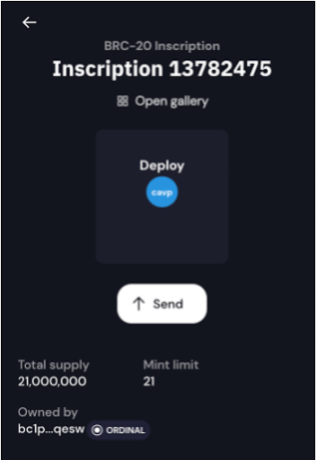
Minting Your BRC-20 Token
Having successfully deployed your BRC20 token, follow these instructions to mint it. Navigate back to the ‘Inscribe Ordinals’ modal located on the Magic Eden homepage. Within the modal, click on the “BRC-20 Mint” tab to proceed.

Enter the four-letter phrase that you deployed earlier, indicate the desired quantity of tokens you intend to mint, and specify the number of mint inscriptions you wish to generate.
Note: The maximum number you can mint per transaction has to be the same with the value set in the “Limit per mint” during the deploy process. Now, click on the “Next” button and select the network fee. After selecting the desired fee rate, click the “Inscribe” button. In the following example, 63 BRC-20 tokens are being minted in three batches of 21 each.

A set of mint transaction links will be provided. Please note that confirming the mint transactions once again may take some time.
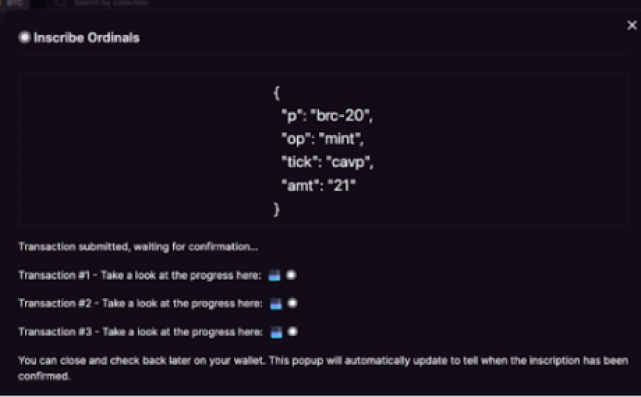
After confirmation, you will receive the mint inscriptions in your connected wallet.
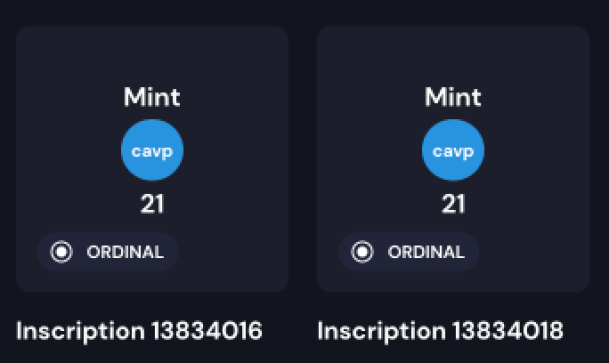
Congratulations, you have successfully created your first BRC-20 Token!
Conclusion
BRC-20 tokens offer fungible tokenization capabilities within the Bitcoin network, enabling a range of applications and use cases. As the blockchain industry progresses, both NFTs and BRC-20 tokens assume crucial roles in shaping the trajectory of digital ownership and decentralized finance (DeFi).
BRC-20 tokens introduce fungible tokenization capabilities within the Bitcoin network, providing the ability to create and exchange interchangeable tokens. This opens up a wide array of possibilities for various applications and use cases within the blockchain industry. As the blockchain ecosystem continues to advance, both NFTs and BRC-20 tokens play pivotal roles in shaping the direction of digital ownership and decentralized finance, driving innovation, and paving the way for a more inclusive and decentralized financial landscape.
Disclaimer: The article is provided for educational purposes only. It does not represent the opinions of NewsBTC on whether to buy, sell or hold any investments and naturally investing carries risks. You are advised to conduct your own research before making any investment decisions. Use information provided on this website entirely at your own risk.
Source link
Academy
How To Create And Mint Your Own NFTs On The Ethereum Network
Published
5 months agoon
February 4, 2024By
admin
The allure of creating your own NFTs and BRC-20 tokens is undeniable. For artists, owning and monetizing their digital creations through NFTs offers a new level of control and potential financial reward. Beyond the realm of art, NFTs can foster passionate communities, grant exclusive access to events, and even act as fundraising tools.
However, stepping into the world of token creation isn’t without its challenges. It demands both a technical understanding of blockchain technology and smart contracts, along with a careful consideration of financial risks and potential regulatory implications. Before diving in, it’s crucial to assess your goals, resources, and risk tolerance. While the possibilities are vast and exciting, responsible and informed action is key to navigating this rapidly evolving landscape.
NFTs, or Non-Fungible Tokens, are digital assets that represent ownership or proof of authenticity for specific items or content. Unlike fungible cryptocurrencies like Bitcoin or Ethereum, NFTs cannot be exchanged on a one-to-one basis due to their unique nature.
NFTs are typically created and traded on blockchain platforms such as Ethereum, Binance Smart Chain, and decentralized marketplaces like OpenSea. These platforms utilize smart contracts to establish ownership and enable transparent and immutable transactions for NFTs.
NFTs can represent a wide range of digital items, including artwork, music, videos, virtual real estate, and collectibles. Each NFT has metadata describing the item it represents and a unique identifier that sets it apart from other NFTs
Creating NFTs On The Ethereum Network
The primary stage in the creation of NFTs involves identifying the content you wish to associate with your NFT. Consider the specific representation you desire for your NFT, whether it be digital artwork, collectibles, virtual real estate, or any other distinct digital item.
In this article, we will use illustrations from OpenSea to guide you on the steps you need to create your own NFTs. OpenSea stands as a leading decentralized marketplace built on the Ethereum blockchain, dedicated to NFTs. It creates a space where users can engage in buying, selling, and discovering an extensive array of digital assets, encompassing artwork, virtual real estate, collectibles, and more.
OpenSea delivers a user-friendly interface, showcasing a vast selection of NFT listings curated from diverse creators and projects. Through OpenSea, users gain the ability to explore the NFT community, partake in auctions, and securely manage their digital assets. With a commitment to fostering the expansion and accessibility of the NFT market, OpenSea ensures a seamless experience for enthusiasts and collectors alike.
This step-by-step guide covers how to create an NFT collection and mint directly to your wallet.
First, visit the original OpenSea website, and click on the “Login” button at the top to connect your preffered wallet.
To figure out the best wallet to use on the Ethereum network, check here.

Next, click on your “Profile Icon” at the top right of your OpenSea interface in order to deploy a smart contract and select “Studio” through the pop-up options.

To initiate the creation of a fresh NFT, simply click the “Create” button located at the top right corner.
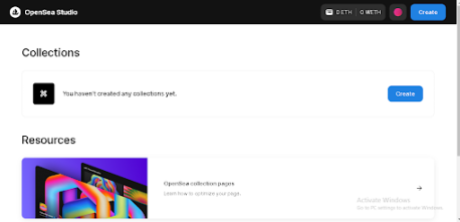
When you explore the options, you will find the choice to either Drop a collection or Create/Mint an NFT. Selecting “Create an NFT”. This will enable you to mint an NFT directly into your wallet.
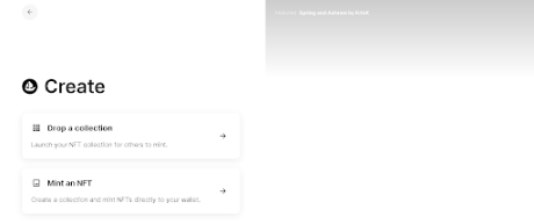
Once you proceed, a fresh “Create an NFT” screen will be presented. If you are using OpenSea Studio tools for the first time to create an NFT, select “Create a new collection.” You will be able to add one NFT to this collection initially, with the option to include more NFTs at a later stage.
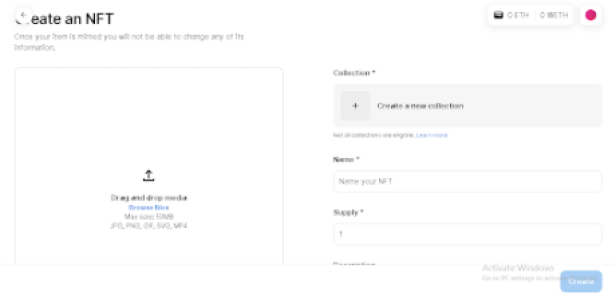
After selecting “Create a new collection,” you will be guided through the steps on your screen to deploy a smart contract. This process will enable you to create NFTs for your newly created collection.
To customize your contract, you need to add a logo image, choose a contract name, and designate a token symbol. Additionally, you will need to choose an EVM blockchain. It’s important to note that deploying a smart contract incurs gas fees, and the estimated fees for each blockchain will be displayed. If the fees are higher than anticipated, you can revisit the process at a later time, as they are subject to change based on network activity.
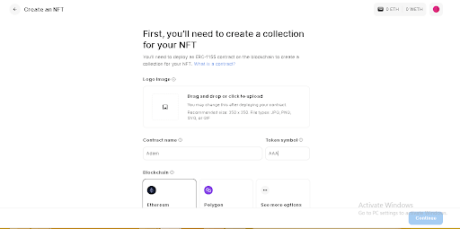
When you are prepared, proceed by clicking on “Continue”. This action will prompt a transaction signature request in your wallet, which will necessitate gas.
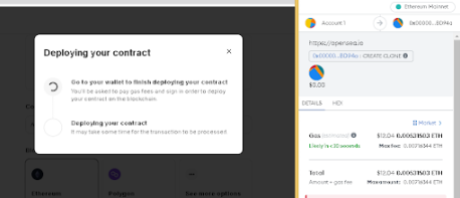
Once the process is finalized, you will receive a confirmation message. Proceed to the next step by selecting “Create an NFT” as shown below. :
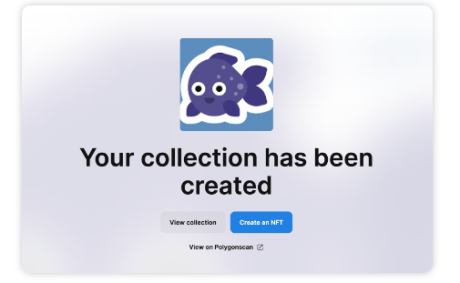
Having successfully created a smart contract, you are now prepared to generate an NFT. It is important to note that once your item is minted, further editing becomes impossible as it permanently resides on the blockchain. In this case, you will be creating an ERC-1155 NFT, which allows for the creation of multiple copies of the same item.
To begin this phase, upload the media for your NFT, which represents the artwork associated with it. Next, choose the collection in which you wish to mint your NFT.
Subsequently, provide a name for your item and set the desired item supply. The item supply determines the number of copies you wish to mint for the NFT. If you choose 1, then the item will be a one-of-one.
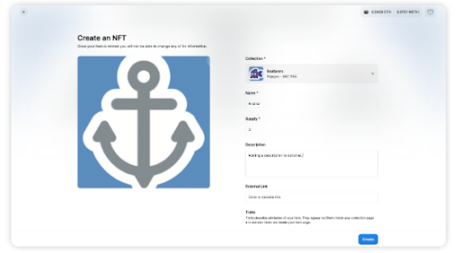
Next, click on the “Create” button at the bottom right, as shown in the above image. A loading message will appear as the item is being minted. To proceed with the minting process, you will need to approve the transaction using your wallet.
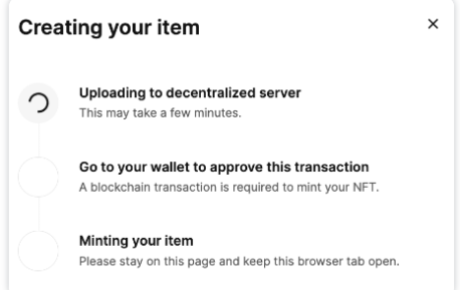
Congratulations! You have successfully minted your very first NFT!
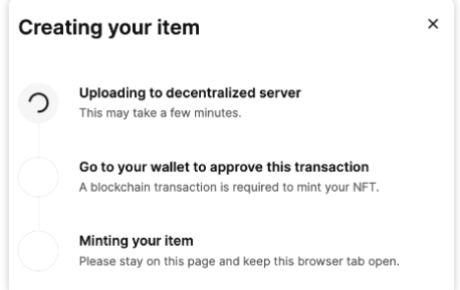
Conclusion
Although NFTs and BRC-20 tokens have distinct functions and operate on separate blockchains, they both contribute to the growing realm of blockchain-based digital assets. NFTs have captured widespread interest for their exceptional nature and capacity to represent ownership of digital assets.
Disclaimer: The article is provided for educational purposes only. It does not represent the opinions of NewsBTC on whether to buy, sell or hold any investments and naturally investing carries risks. You are advised to conduct your own research before making any investment decisions. Use information provided on this website entirely at your own risk.
Source link

What’s the best new crypto in 2024?

Bitcoin Mining Difficulty Crashes 5% To Lowest Level In 3 Months, What Happens Next?
Bitcoin (BTC) Price, Volume Contrasts In Fight For Rebound

The German Government Is Selling More Bitcoin – $28 Million Moves to Exchanges
BC.GAME Announces the Partnership with Leicester City and New $BC Token!

Justin Sun Says TRON Team Designing New Gas-Free Stablecoin Transfer Solution

Mt. Gox is a ‘thorn in Bitcoin’s side,’ analyst says

XRP Eyes Recovery Amid Massive Accumulation, What’s Next?

Germany Moves Another $28 Million in Bitcoin to Bitstamp, Coinbase

'Asia's MicroStrategy' Metaplanet Buys Another ¥400 Million Worth of Bitcoin

BlackRock’s BUIDL adds over $5m in a week despite market turbulence

Binance To Delist All Spot Pairs Of These Major Crypto

German Government Sill Holds 39,826 BTC, Blockchain Data Show

HIVE Digital stock rallies over 9% as Bitcoin miner bolsters crypto reserves to 2.5k BTC

Pepe Price Analysis Reveals Bullish Strength As Bitcoin Plummets

Bitcoin Dropped Below 2017 All-Time-High but Could Sellers be Getting Exhausted? – Blockchain News, Opinion, TV and Jobs

What does the Coinbase Premium Gap Tell us about Investor Activity? – Blockchain News, Opinion, TV and Jobs
BNM DAO Token Airdrop
A String of 200 ‘Sleeping Bitcoins’ From 2010 Worth $4.27 Million Moved on Friday

NFT Sector Keeps Developing – Number of Unique Ethereum NFT Traders Surged 276% in 2022 – Blockchain News, Opinion, TV and Jobs
New Minting Services

Block News Media Live Stream

SEC’s Chairman Gensler Takes Aggressive Stance on Tokens – Blockchain News, Opinion, TV and Jobs

Friends or Enemies? – Blockchain News, Opinion, TV and Jobs

Enjoy frictionless crypto purchases with Apple Pay and Google Pay | by Jim | @blockchain | Jun, 2022

How Web3 can prevent Hollywood strikes

Block News Media Live Stream

Block News Media Live Stream

Block News Media Live Stream

XRP Explodes With 1,300% Surge In Trading Volume As crypto Exchanges Jump On Board
Trending

 Altcoins2 years ago
Altcoins2 years agoBitcoin Dropped Below 2017 All-Time-High but Could Sellers be Getting Exhausted? – Blockchain News, Opinion, TV and Jobs

 Binance2 years ago
Binance2 years agoWhat does the Coinbase Premium Gap Tell us about Investor Activity? – Blockchain News, Opinion, TV and Jobs
- Uncategorized3 years ago
BNM DAO Token Airdrop

 Bitcoin miners2 years ago
Bitcoin miners2 years agoA String of 200 ‘Sleeping Bitcoins’ From 2010 Worth $4.27 Million Moved on Friday

 BTC1 year ago
BTC1 year agoNFT Sector Keeps Developing – Number of Unique Ethereum NFT Traders Surged 276% in 2022 – Blockchain News, Opinion, TV and Jobs
- Uncategorized3 years ago
New Minting Services

 Video2 years ago
Video2 years agoBlock News Media Live Stream

 Bitcoin1 year ago
Bitcoin1 year agoSEC’s Chairman Gensler Takes Aggressive Stance on Tokens – Blockchain News, Opinion, TV and Jobs

